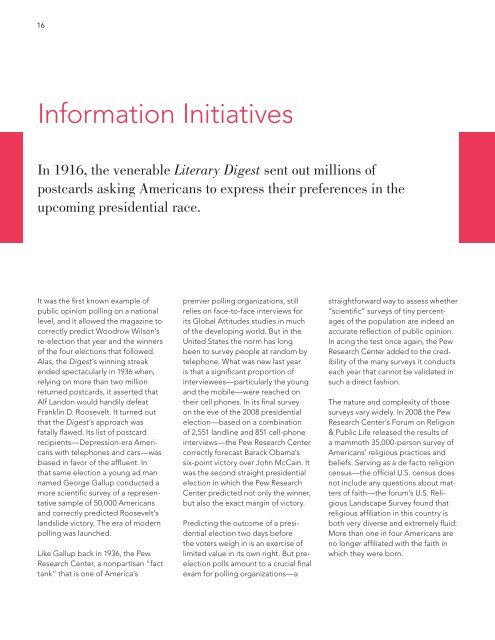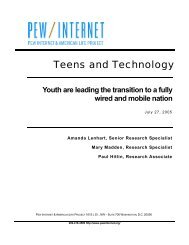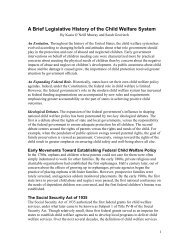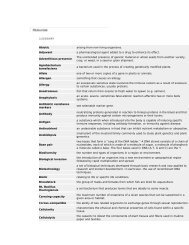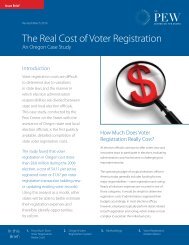PROSPECTUS - The Pew Charitable Trusts
PROSPECTUS - The Pew Charitable Trusts
PROSPECTUS - The Pew Charitable Trusts
Create successful ePaper yourself
Turn your PDF publications into a flip-book with our unique Google optimized e-Paper software.
16<br />
Information Initiatives<br />
In 1916, the venerable Literary Digest sent out millions of<br />
postcards asking Americans to express their preferences in the<br />
upcoming presidential race.<br />
It was the first known example of<br />
public opinion polling on a national<br />
level, and it allowed the magazine to<br />
correctly predict Woodrow Wilson’s<br />
re-election that year and the winners<br />
of the four elections that followed.<br />
Alas, the Digest’s winning streak<br />
ended spectacularly in 1936 when,<br />
relying on more than two million<br />
returned postcards, it asserted that<br />
Alf Landon would handily defeat<br />
Franklin D. Roosevelt. It turned out<br />
that the Digest’s approach was<br />
fatally flawed. Its list of postcard<br />
recipients—Depression-era Americans<br />
with telephones and cars—was<br />
biased in favor of the affluent. In<br />
that same election a young ad man<br />
named George Gallup conducted a<br />
more scientific survey of a representative<br />
sample of 50,000 Americans<br />
and correctly predicted Roosevelt’s<br />
landslide victory. <strong>The</strong> era of modern<br />
polling was launched.<br />
Like Gallup back in 1936, the <strong>Pew</strong><br />
Research Center, a nonpartisan “fact<br />
tank” that is one of America’s<br />
premier polling organizations, still<br />
relies on face-to-face interviews for<br />
its Global Attitudes studies in much<br />
of the developing world. But in the<br />
United States the norm has long<br />
been to survey people at random by<br />
telephone. What was new last year<br />
is that a significant proportion of<br />
interviewees—particularly the young<br />
and the mobile—were reached on<br />
their cell phones. In its final survey<br />
on the eve of the 2008 presidential<br />
election—based on a combination<br />
of 2,551 landline and 851 cell-phone<br />
interviews—the <strong>Pew</strong> Research Center<br />
correctly forecast Barack Obama’s<br />
six-point victory over John McCain. It<br />
was the second straight presidential<br />
election in which the <strong>Pew</strong> Research<br />
Center predicted not only the winner,<br />
but also the exact margin of victory.<br />
Predicting the outcome of a presidential<br />
election two days before<br />
the voters weigh in is an exercise of<br />
limited value in its own right. But preelection<br />
polls amount to a crucial final<br />
exam for polling organizations—a<br />
straightforward way to assess whether<br />
“scientific” surveys of tiny percentages<br />
of the population are indeed an<br />
accurate reflection of public opinion.<br />
In acing the test once again, the <strong>Pew</strong><br />
Research Center added to the credibility<br />
of the many surveys it conducts<br />
each year that cannot be validated in<br />
such a direct fashion.<br />
<strong>The</strong> nature and complexity of those<br />
surveys vary widely. In 2008 the <strong>Pew</strong><br />
Research Center’s Forum on Religion<br />
& Public Life released the results of<br />
a mammoth 35,000-person survey of<br />
Americans’ religious practices and<br />
beliefs. Serving as a de facto religion<br />
census—the official U.S. census does<br />
not include any questions about matters<br />
of faith—the forum’s U.S. Religious<br />
Landscape Survey found that<br />
religious affiliation in this country is<br />
both very diverse and extremely fluid:<br />
More than one in four Americans are<br />
no longer affiliated with the faith in<br />
which they were born.


